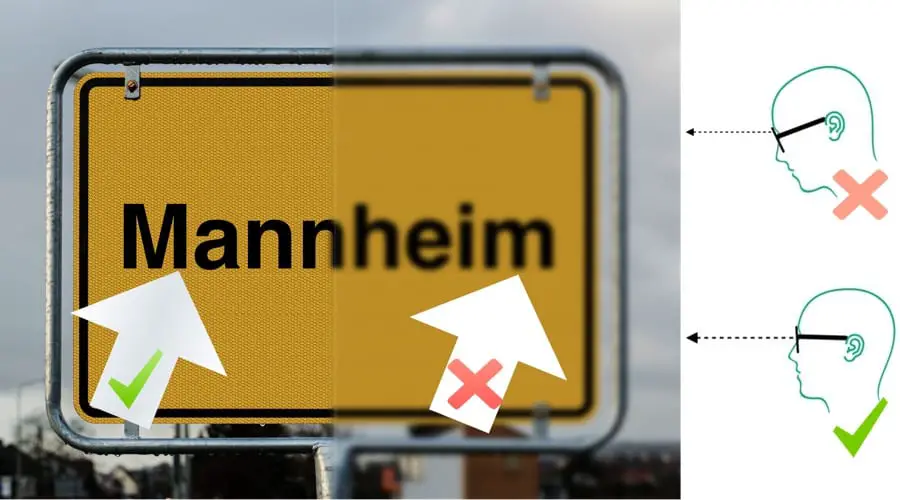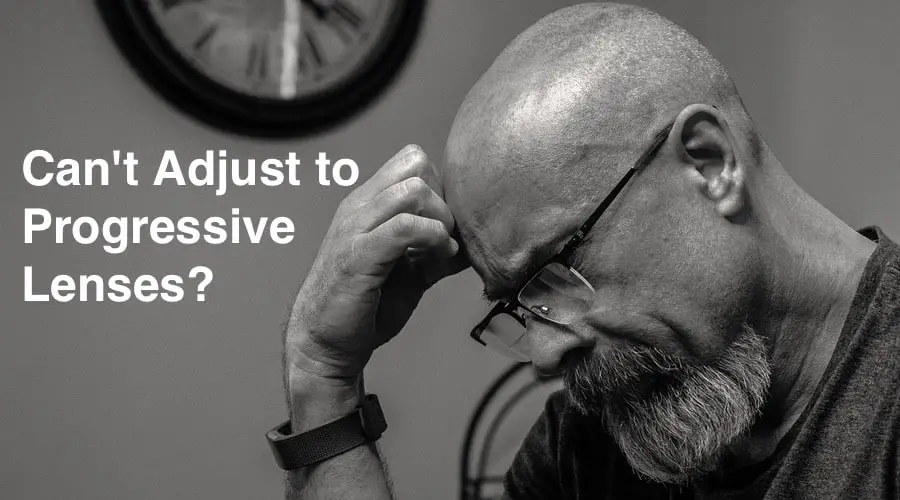We will tell you which little detail you should have an eye on to know if your progressive lenses are correct.
You should be able to maintain a natural posture in your neck and see sharp when reading or while focusing on the distance. If you need to raise your chin really high while reading or hold it really low to see in the distance something is not correct.
There are two parts of the lens you can check if your lenses are correct. The first is how the lens sits in front of your eyes. If you are not able to see in the distance either centration is way off and the lenses are too high or the lens power is not correct.
Try This to See If the Lenses Are Too High
- Look at an object in a distance with a distance of 65 feet away from you or more.
- If you can not see it clear, keep your eyes on the object and lower your chin. Does it get better while looking through a more upper part in the lens than your lenses are too high.

Try This to See If the Lenses Are Too Low
- Hold something you want to read in your hands and lower your look with your eyes. Do not move your chin down as you look down.
- If you can not read without lifting the glasses up. The lenses are too low.
Try This If You Can Not Read with Your Progressives
- Hold something you want to read in your hands and lower your look with your eyes. Do not move your chin down as you look down.
- Now look down at something to read but do not lower your chin. Look at something you want to read.
- Rotate your head to the left and right. Just use one eye at a time. If you can read in a rotated position the reading zones are out of place. When you can not read at all the prescription seems to be wrong.
Why Are My Progressive Lenses Blurry?
Progressive lenses are by their design blurry on the sides. If you want to produce the reading zone in the lower middle part of a lens an error on the sides will occur. The error is called surface astigmatism and causes the blur in every progressive lens design on the market.
However, as long as you stay in your natural posture you should be able to see clearly in the distance, and as soon as you lower your look to something in the near range. The amount of blurriness in your progressive lenses is dependent on the power of the reading zone. The more powerful it has to be the more you can take notice of the surface astigmatisms on the sides in the lower part of the lens.
That leads to the conclusion to produce progressive lenses with the widest view possible. And this can be achieved by placing the sharp zones as perfectly as possible in front of your eyes.

The blue zones represent a crystal clear vision. As soon as you perform eye movements into the green zones you will immediately recognize a slight blur occurring. If your eyes move even further into the red or yellow zones the blur will be a lot stronger to the point you actually can not read at all.
In the picture above, you can see a comparison of a standard progressive lens on the left and a progressive lens with individual parameters. When those individual parameters are optimally set the clear zones are placed as perfect as possible to produce the widest view. If not the left part of the picture can be the result.
But frankly spoken the result highly depends on the wearers’ pupilar distance, vertex distance, the pantoscopic tilt of the frame, the prescription, power the reading zones, and a few things more. If your parameters are pretty close to the standards you might not even have such a big difference as shown above.
Can’t Adjust to Progressive Lenses?
There are definitely two to three weeks in which you should adjust to progressives. In this time you develop movement patterns in which you do not need to search the clear zones. You just automatically point your nose a little bit more into the direction you want to see sharp. If that does not happen there are three possibilities why you can’t adjust to it.
The first thing that can hold you back from getting used to your progressives is the wrong prescription. With small mistakes in the measurements, your field of view can be noticeable minimized, or not be usable at all. The zones you can use are dependent on the precise measured needed lens power. So if you buy the highest-tech progressives on the market and the eye test is made in a slipshod way in 5 minutes the lenses can never unfold their full potential. So choose an optician who actually cares about the eye-test.
Second, if you have the highest-end progressives on the market and the lenses are not sitting where they are supposed to be probably will not accept the progressives. A word of caution though. Your body can adapt to a lot of situations. A lot of people live with glasses that are not sitting optimally in front of their eyes. If that happens they tend to leave their natural posture to compensate for the wrong position of the lenses.

Obviously, this can cause problems. The part with the centration is key so you can adjust to the lenses in the easiest way possible. Last but not least there are some people that just will not adjust to progressives no matter what. But the amount of people that really can not wear those glasses is really small. In a study in 2015 from Exler Linda the satisfaction from 243 wearers of progressive glasses was tested.
81,5% were satisfied with there new progressive glasses.
Study by Exler Linda
What you hear oftentimes is people are not satisfied with the lenses because they just have their limitations but they do not want to miss them either (But this was not a part of the study). Besides the centration and prescription part I already mentioned, the consultation plays a big role. Most people do not exactly know what they can expect of their new progressives.
And if you expect something of your glasses and it was not talked about that this is definitely not possible with this type of lens, of course, you can not adjust to it. But this consultation can only be taken place if the optician has the time to talk to you, show you differences and give you a better understanding of what you are actually buying.
This part is obviously highly dependent on the optician in front of you. If a person is really willing to find great solutions for you. Notice, I mentioned the solution in the plural. In most cases on pair of progressives does not cut it. A lot of people just having one pair of progressives and they are using a PC screen daily. The area for the PC distance is tiny and really uncomfortable to use over an extended amount of time. PC glasses would work better in addition to the normal glasses.
When you just want to hang around in front of your TV and you lay down. In most cases, your progressives will not work. Get an additional pair of distance vision lenses and you will be fine. Ask the optician what the changes in prescription of in lens design mean to you. That way you will avoid situations in which you can not adjust to your progressive glasses.

